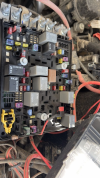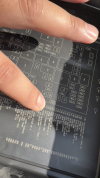boogielander
Spends too much time on here
- Joined
- Jun 29, 2022
- Messages
- 3,560
- Reaction score
- 5,668
- Points
- 113
oh yeah if I didn't have a Renogy solar controller then I'd be looking at options with MPPT.Boogielander, thanks very much for the detail, and please do let me know which engine bay IGN fuse number you connected to and the description of this fuse from the owner's manual (just because our different model year trucks might have a slightly different fuse layout and fuse numbers).
I encountered the exact problem you did with insufficient voltage to charge my camper battery from the starting battery. I use portable solar panels so the Renogy DCDC with mppt allows me to both direct charge and solar charge via one device that has similar capabilities as your Victron.
And the only place I can find to mount this charger is in the very back of my camper, so I'm using 4 AWG wire, and other than this our setups are very similar.
I think that several readers of this forum would appreciate your detailed writeup and photos when you get to it.
Another method that my friend uses is way more capacity but also bank:
Same Victron setup, but instead of Ecoflow Delta 2 he uses Delta 2 Max with 2 Delta 2 Max Add-on Batteries giving him 6kw of power total. Delta 2 Max has dual input capacity, so he also has 2 Bouge RV 200w solar panels permanently mounted on the roof of his GFC. That pushes out around 600w on a sunny day while driving. No MPPT controller needed since Delta 2 Max has that built in.
But the downside is, that is a $5k setup excluding Victron lol BUT at the same time we were using air fryer to make breakfast and his +1 can use hairdryer. Oh, and we can run Starlink whole night too. In addition, he has fridge hardwired to his truck (with stock dual battery setup) from years ago, so he also has a noco charger that charges the two batteries while engine's not running.
For me i'm happy with 3kw of power because i'm not using air fryer and hair dryer when i do solo overland. I don't have an air fryer and being single with military style hair cut means no hair dryer needed. I can still run fridge and Starlink whole night on just a bit over 1kw/ night and charge it all back within a few hours of driving. All other smaller items that charge via USB can be plugged to the truck or EcoFlow if needed. For days that I establish basecamp I also have portable panels (2x160w Ecoflow portable). I also have one Renogy 170w flexible sitting at home to be installed back on (my old Renogy 100w flexible panel flew away... long story short it was attached to my soft shell wedge style RTT and it held on for half a year until I decided to do 90mph into headwind right around Memorial Day. I'm still trying to find a good solution to attach the new panel)
My setup is only $2496 before Victron.













